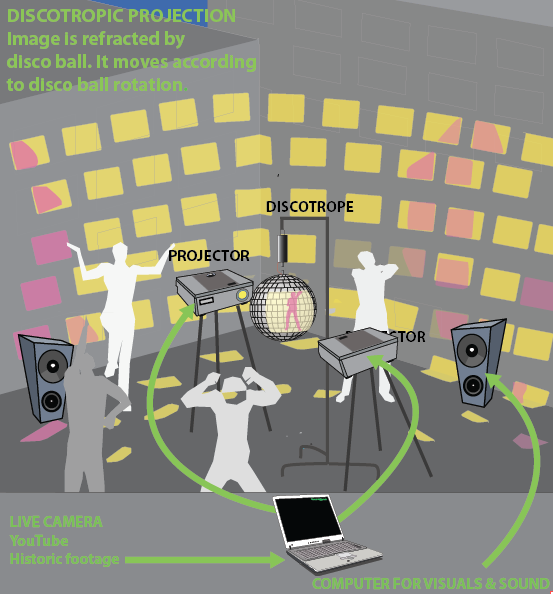How
Posted by discotrope
How it works, how the “science” relates to the “art,” and how two grown women found themselves wiring hundreds of solar panels to a nightclub ornament and trying to delicately leverage deceleration using Uncle Louie’s polka.

The Discotrope is an absurd yet functional alternative energy device. Annina has replaced several rows of mirrors on the disco ball with identically sized solar cells and hooked them up to a motor. (You didn’t know you could order solar cells in “Disco Ball Mirror Form Factor,” now did you?) With video projectors pointed at the ball during performance, Discotrope recuperates energy from the light of the projectors to turn the ball’s motor. Not very much energy, mind you – we need most of it to reflect nice-looking stuff onto the walls. So the solar panels generate the visual imagery, and at the same time, they generate electricity that causes the ball to rotate – thereby setting the imagery in motion. While wildly inefficient if approached primarily as an energy generator, if you look at Discotrope as an aesthetics generator that powers itself as a byproduct, it’s not so terrible, is it?
Discotrope doesn’t just keep moving at one speed, though. The ball’s rotation speed fluctuates depending on how much light the solar cells get – which is in turn determined by the brightness of the video images at any given moment. The brighter the images, the faster the motor rotates the ball, the faster the images fly around the room. When the images are darker, the ball slows down and eventually stops. Although the videos keep running, the reflections stop moving through the room, giving the feeling they’ve paused to catch their breath before starting to “dance” through space again. Of course, it’s not quite that simple – a little thing called “inertia” complicates matters. All of this makes controlling Discotrope a total bear – but that’s part of what makes it interesting as a visual performance instrument. It presents an opportunity for developing a style of visual performance that cooperates with the physical properties at play to “choreograph” the imagery. Amy is developing custom video performance software for Discotrope in Max/Jitter to analyze and manipulate the visuals accordingly, while working on creating a performative visual language that deals with light, color, movement, gesture, energy and inertia. (Fortunately, earth, wind, fire and water were otherwise engaged.)
We’re currently working with composer Cristyn Magnus to create a custom sound design that will incorporate both the videos’ soundtracks and original music. The sound will be generated in real time to match the video choices that we improvise live in performance. Cristyn is composing her software in Pure Data, and it will communicate with Amy’s visual performance software using the Open Sound Control (OSC) protocol.
